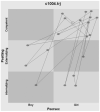Patterns of gender development
- PMID: 19575615
- PMCID: PMC3747736
- DOI: 10.1146/annurev.psych.093008.100511
Patterns of gender development
Abstract
A comprehensive theory of gender development must describe and explain long-term developmental patterning and changes and how gender is experienced in the short term. This review considers multiple views on gender patterning, illustrated with contemporary research. First, because developmental research involves understanding normative patterns of change with age, several theoretically important topics illustrate gender development: how children come to recognize gender distinctions and understand stereotypes, and the emergence of prejudice and sexism. Second, developmental researchers study the stability of individual differences over time, which elucidates developmental processes. We review stability in two domains-sex segregation and activities/interests. Finally, a new approach advances understanding of developmental patterns, based on dynamic systems theory. Dynamic systems theory is a metatheoretical framework for studying stability and change, which developed from the study of complex and nonlinear systems in physics and mathematics. Some major features and examples show how dynamic approaches have been and could be applied in studying gender development.
Figures


References
-
- Adolph KE, Vereijken B, Shrout PE. What changes in infant walking and why. Child Dev. 2003;74:475–97. - PubMed
-
- Alexander GM, Hines M. Gender labels and play styles: their relative contribution to children's selection of playmates. Child Dev. 1994;65:869–79. - PubMed
-
- Arthur AE, Bigler RS, Liben LS, Gelman SA, Ruble DN. Gender stereotyping and prejudice: a developmental intergroup perspective. In: Levy S, Killen M, editors. Intergroup Attitudes and Relations in Childhood Through Adulthood. Oxford Univ. Press; New York: 2008. pp. 66–85.
-
- Ashmore RD, Deaux K, McLaughlin-Volpe T. An organizing framework for collective identity: articulation and significance of multidimensionality. Psychol. Bull. 2004;130:80–114. - PubMed
-
- Bak P, Chen K, Creutz M. Self-organized criticality in the “Game of Life.”. Nature. 1989;342:780–81.

